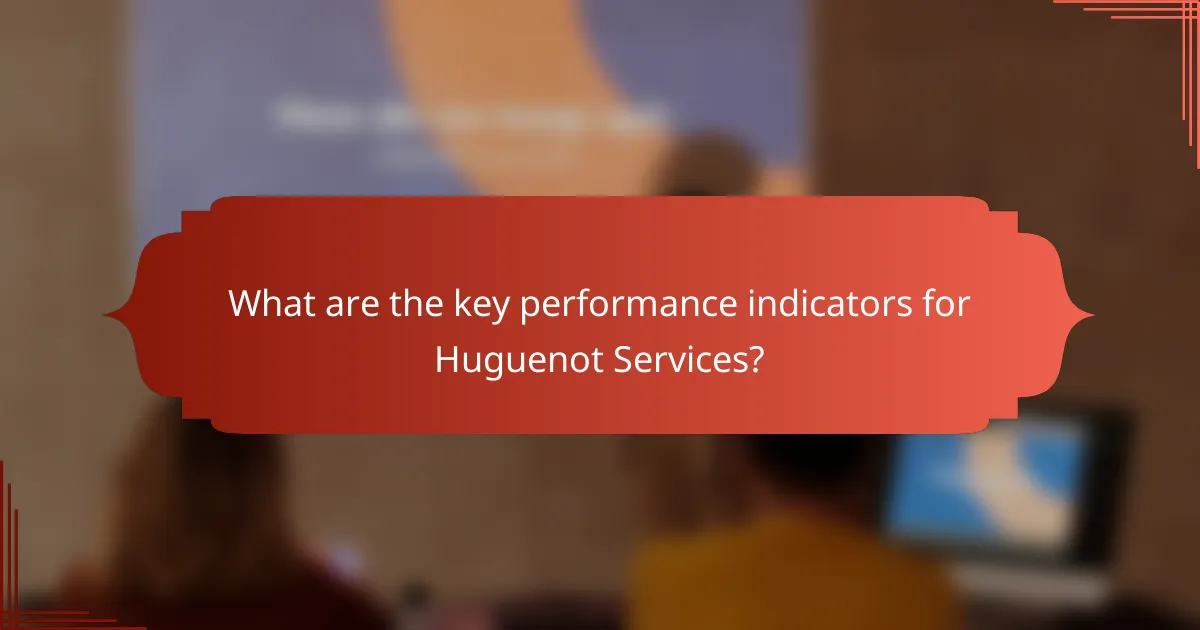Key performance indicators (KPIs) for Huguenot Services are vital for evaluating the effectiveness and efficiency of their operations. By focusing on metrics such as client satisfaction, service efficiency, and employee performance, organizations can make informed decisions that drive continuous improvement and enhance service delivery within the community.

What are the key performance indicators for Huguenot Services?
Key performance indicators (KPIs) for Huguenot Services are essential metrics that help assess the effectiveness and efficiency of their operations. These indicators provide insights into client satisfaction, service efficiency, cost management, employee performance, and retention rates, enabling informed decision-making and continuous improvement.
Client satisfaction score
The client satisfaction score measures how well Huguenot Services meets the expectations of its clients. This score is typically derived from surveys and feedback forms, where clients rate their experiences on a scale, often from 1 to 10.
To improve this metric, focus on gathering detailed feedback and addressing common concerns. Regularly review scores to identify trends and areas for enhancement, aiming for a score in the high 80s to low 90s percentile for optimal satisfaction.
Service delivery time
Service delivery time tracks the duration taken to fulfill client requests. This metric is crucial for understanding operational efficiency and client satisfaction, as quicker delivery often leads to higher satisfaction.
Benchmark service delivery times against industry standards, which may range from a few hours to several days, depending on the service type. Implementing streamlined processes and technology can help reduce delivery times and enhance client experiences.
Cost per service
Cost per service calculates the total expenses incurred to deliver a specific service, including labor, materials, and overhead. Monitoring this KPI helps in budgeting and pricing strategies.
To manage costs effectively, analyze historical data to identify average costs and set targets for reduction. Aim for a cost structure that allows for competitive pricing while maintaining quality, typically within a few hundred to a few thousand dollars, depending on service complexity.
Employee productivity metrics
Employee productivity metrics assess how effectively staff members contribute to service delivery. This can include the number of services completed per employee or the time taken to complete tasks.
To enhance productivity, establish clear performance goals and provide training to improve skills. Regularly review these metrics to identify high performers and areas needing support, aiming for a balanced workload across teams.
Retention rates
Retention rates indicate the percentage of clients who continue to use Huguenot Services over a specific period. High retention rates suggest strong client loyalty and satisfaction.
To improve retention, focus on building relationships and providing exceptional service. Monitor retention trends and implement loyalty programs or follow-up strategies to keep clients engaged, aiming for retention rates above 70% to 80% as a benchmark for success.

How to measure the effectiveness of Huguenot Services?
Measuring the effectiveness of Huguenot Services involves assessing various performance indicators that reflect customer satisfaction, service usage, and industry benchmarks. By focusing on customer feedback, usage data, and comparisons with industry standards, organizations can gain valuable insights into their service performance.
Utilizing customer feedback surveys
Customer feedback surveys are essential for gauging satisfaction and identifying areas for improvement in Huguenot Services. These surveys can be distributed through various channels, such as email, online forms, or during service interactions, and should include both quantitative and qualitative questions.
To maximize response rates, consider offering incentives or ensuring anonymity. Aim for a response rate of at least 20-30% to gather meaningful data, and analyze the results to identify trends and specific areas that require attention.
Analyzing service usage data
Service usage data provides insights into how often and in what ways customers engage with Huguenot Services. Tracking metrics such as frequency of use, duration of service interactions, and customer retention rates can reveal patterns that indicate service effectiveness.
Utilize analytics tools to visualize this data, making it easier to spot trends over time. For instance, if usage spikes during specific periods, this may highlight successful marketing efforts or seasonal demand, allowing for better resource allocation.
Benchmarking against industry standards
Benchmarking against industry standards helps Huguenot Services assess their performance relative to competitors. This process involves comparing key performance indicators (KPIs) such as customer satisfaction scores, service response times, and operational efficiency metrics.
Identify relevant industry benchmarks, which can often be found in reports from trade associations or market research firms. Regularly review these benchmarks to ensure that your services remain competitive and to set realistic improvement goals based on industry best practices.

What metrics are essential for Huguenot Services in Ireland?
Essential metrics for Huguenot Services in Ireland include local market penetration rate, compliance with local regulations, and community engagement levels. These indicators help assess the effectiveness and impact of services offered within the community.
Local market penetration rate
The local market penetration rate measures the extent to which Huguenot Services reach their target audience in Ireland. A higher penetration rate indicates effective outreach and service adoption among the community.
To evaluate this metric, consider tracking the number of clients served relative to the estimated population in the target area. For instance, a penetration rate of 20-30% may signify strong engagement in a localized market.
Compliance with local regulations
Compliance with local regulations is crucial for Huguenot Services to operate legally and effectively in Ireland. This includes adherence to health, safety, and data protection laws relevant to service delivery.
Regular audits and assessments should be conducted to ensure that all operational practices align with the current legal framework. Non-compliance can lead to penalties and damage to reputation, so maintaining up-to-date knowledge of regulations is essential.
Community engagement levels
Community engagement levels reflect how well Huguenot Services connect with and involve local residents. High engagement can lead to increased trust and support for services offered.
To measure engagement, consider conducting surveys or hosting community events to gather feedback and participation rates. Aim for active involvement from various demographics, which can enhance service relevance and effectiveness in the community.
![]()
What tools can enhance KPI tracking for Huguenot Services?
Several tools can significantly improve KPI tracking for Huguenot Services, enabling better decision-making and performance evaluation. Utilizing the right combination of analytics, customer relationship management, and project management software can streamline data collection and analysis.
Google Analytics for web performance
Google Analytics is essential for tracking web performance metrics such as page views, bounce rates, and user engagement. By setting up goals and conversions, Huguenot Services can measure the effectiveness of their online presence and marketing efforts.
To maximize its utility, regularly review the data and adjust strategies based on user behavior. For instance, if a particular page has a high bounce rate, consider revising its content or layout to improve user retention.
CRM systems for customer insights
Customer Relationship Management (CRM) systems provide valuable insights into customer interactions and preferences. By analyzing data from these systems, Huguenot Services can identify trends, segment their audience, and tailor their services accordingly.
Choosing a CRM that integrates well with existing tools is crucial. Look for features like automated reporting and customizable dashboards to ensure that key metrics are easily accessible and actionable.
Project management software for efficiency
Project management software helps track project progress, resource allocation, and team performance, which are vital for achieving KPIs. Tools like Trello or Asana can facilitate collaboration and keep everyone aligned on objectives and deadlines.
Implementing a project management tool requires training and buy-in from the team. Establish clear workflows and regularly review project metrics to identify areas for improvement and ensure that projects stay on track.

How to set realistic performance targets for Huguenot Services?
Setting realistic performance targets for Huguenot Services involves analyzing historical data, understanding current capabilities, and aligning goals with stakeholder expectations. This ensures that targets are achievable and relevant to the service’s objectives.
Using historical data for forecasting
Utilizing historical data is essential for accurate forecasting in Huguenot Services. By examining past performance metrics, organizations can identify trends and patterns that inform future targets. For instance, if service response times have consistently improved by 10-15% annually, setting a target within this range for the upcoming year is reasonable.
When analyzing historical data, consider factors such as seasonal fluctuations and changes in service demand. This context helps in adjusting targets to reflect realistic expectations. A simple approach is to calculate the average performance over several years and use that as a baseline for future targets.
Involving stakeholders in target setting
Involving stakeholders in the target-setting process is crucial for ensuring that the goals are aligned with their needs and expectations. Engaging team members, clients, and management can provide diverse perspectives that enhance the relevance of the targets. For example, gathering input from frontline staff can reveal operational challenges that may affect target feasibility.
To effectively involve stakeholders, consider conducting workshops or surveys to gather feedback. This collaborative approach not only fosters buy-in but also helps identify potential obstacles early in the process. Aim to establish clear communication channels to keep stakeholders informed and engaged throughout the target-setting journey.
